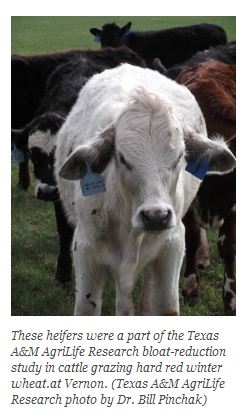



Adding Enzymes Could Reduce Bloat
Frothy bloat in cattle grazing hard red winter wheat is the major non-pathogenic cause of death in the southern Great Plains which is why Texas University researchers have been looking into decreasing the severity of the condition, writes Kay Ledbetter for Texas Agrilife.The study of a sample of heifers was part of the Texas A&M AgriLife Research bloat-reduction study in cattle grazing hard red winter wheat.at Vernon. (Texas A&M AgriLife Research photo by Dr. Bill Pinchak)
Dr. Bill Pinchak of Vernon, head of the Bloat Research Project, has spent eight years developing intervention strategies to mitigate direct bloat impacts, while enhancing performance in non-bloated animals.
Pinchak said frothy bloat is a costly disease, with an estimated $40 million negative impact on the beef cattle industry.
The bloat occurs when a polysaccharide biofilm coats the contents of the rumen. When it comes in contact with fluid and rumen contents, the fermentative gases are trapped and the animal is prevented from belching the excess gas, he said.
Previous research has determined condensed plant tannin extracts, ionophores, surfactants and pre-plant nitrogen fertilization effectively mitigate bloat. Tannin extracts and ionophores also improve animal performance.
However, Pinchak said, there is currently no Food and Drug Administration clearance for condensed tannin extract use as a feed additive and ionophores use an antibiotic axis for intervention. So his group has continued to search for and evaluate non-antibioltic alternative technologies to mitigate bloat and improve performance of cattle grazing bloat-prone forages.
Supplemental enzymes, particularly proteases, cellulases, amylases and xylanases, were thought to have bloat intervention potential. Pinchak’s group chose to evaluate a multi-enzyme product to determine its mitigation potential for cattle grazing bloat-prone wheat forage.
“Our early studies have shown that a multi-enzyme supplement could decrease the rate and extent of polysaccharide formation, thereby decreasing bloat severity and duration,” Pinchak said.
As a part of his group’s enzyme research, an in-vitro experiment utilizing rumen fluid from bloated and non-bloated rumen-cannulated steers and four levels of a multi-enzyme product was conducted. In this study, BovaZyme WP by York Ag Products in York, Pa. was the multi-enzyme product used, he said.
The multi-enzyme supplementation to rumen fluid reduced foam strength, time of foam collapse, biofilm and viscosity, Pinchak said.
Subsequently, a grazing experiment was conducted with 65 crossbred heifers in three replicated groups using mineral alone as a control and mineral plus multi-enzyme in supplemented herds, he said.
During the 77-day study, 58 of 65 head, or 89 percent of the cattle, experienced at least one bloat event. The number of head experiencing bloat more than four days was greater in the control set of cattle, more than two extra days, than in the mineral plus multi-enzyme herds.
Conversely, the percentage of cattle experiencing only minor bloat was greater in the mineral plus multi-enzyme set of cattle than in the control herds, 34.7 percent compared to 19.3 percent, respectively.
Collectively, Pinchak said, a multi-enzyme with mineral supplementation decreased the severity and duration of bloat under the grazing conditions of this experiment.
Total gain and average daily gain for the grazing period also was greater for the mineral plus multi-enzyme-supplemented mineral group than for the mineral only control group at 14.8 pounds per head and 0.15 pound per head per day, respectively.
Pinchak said the results from these preliminary experiments show that there is promise for a multi-enzyme supplement added to a complete mineral supplement as a value added bloat-mitigation program. However, he said, further research is warranted over several years to validate the results of this research.




